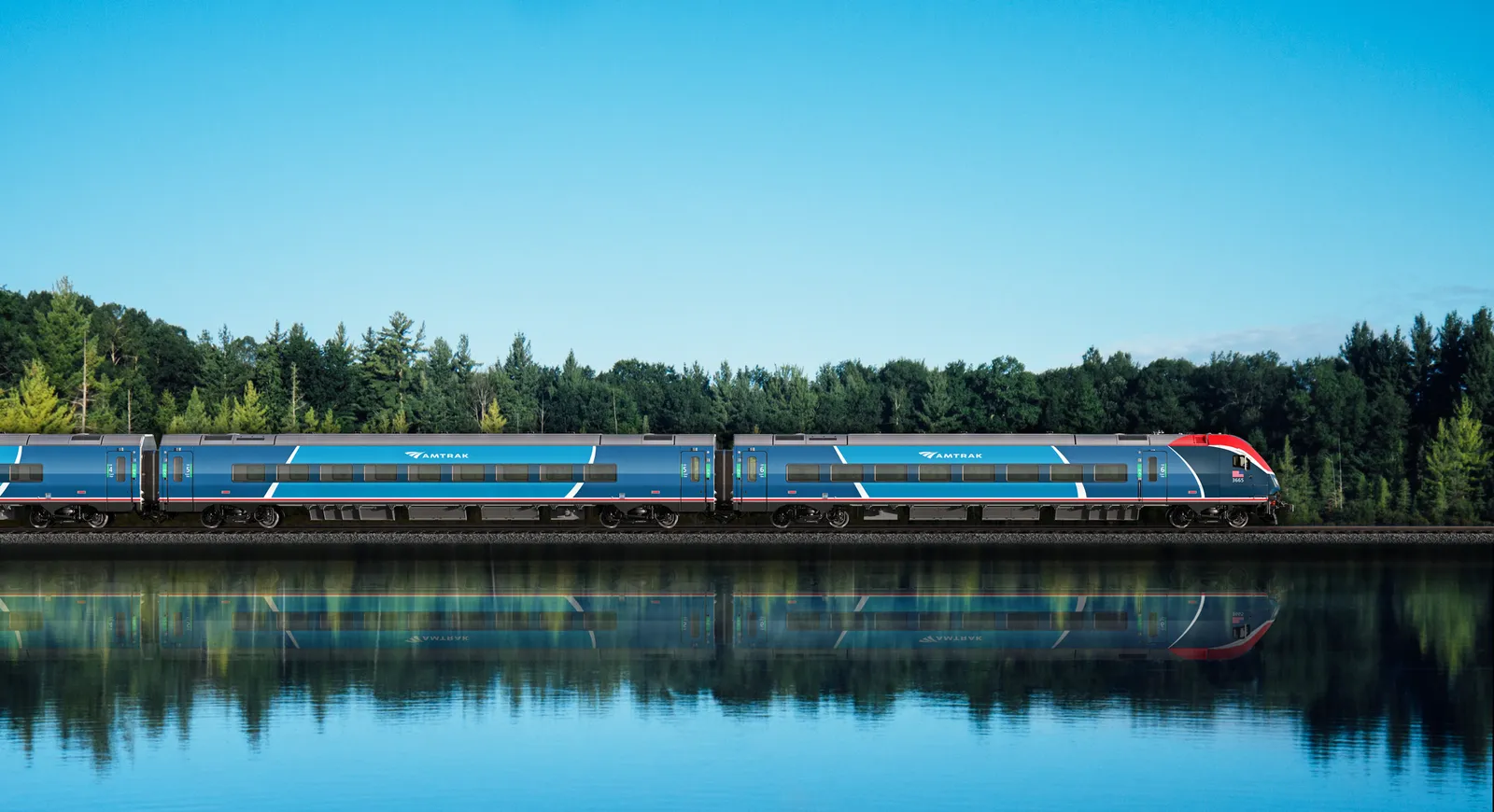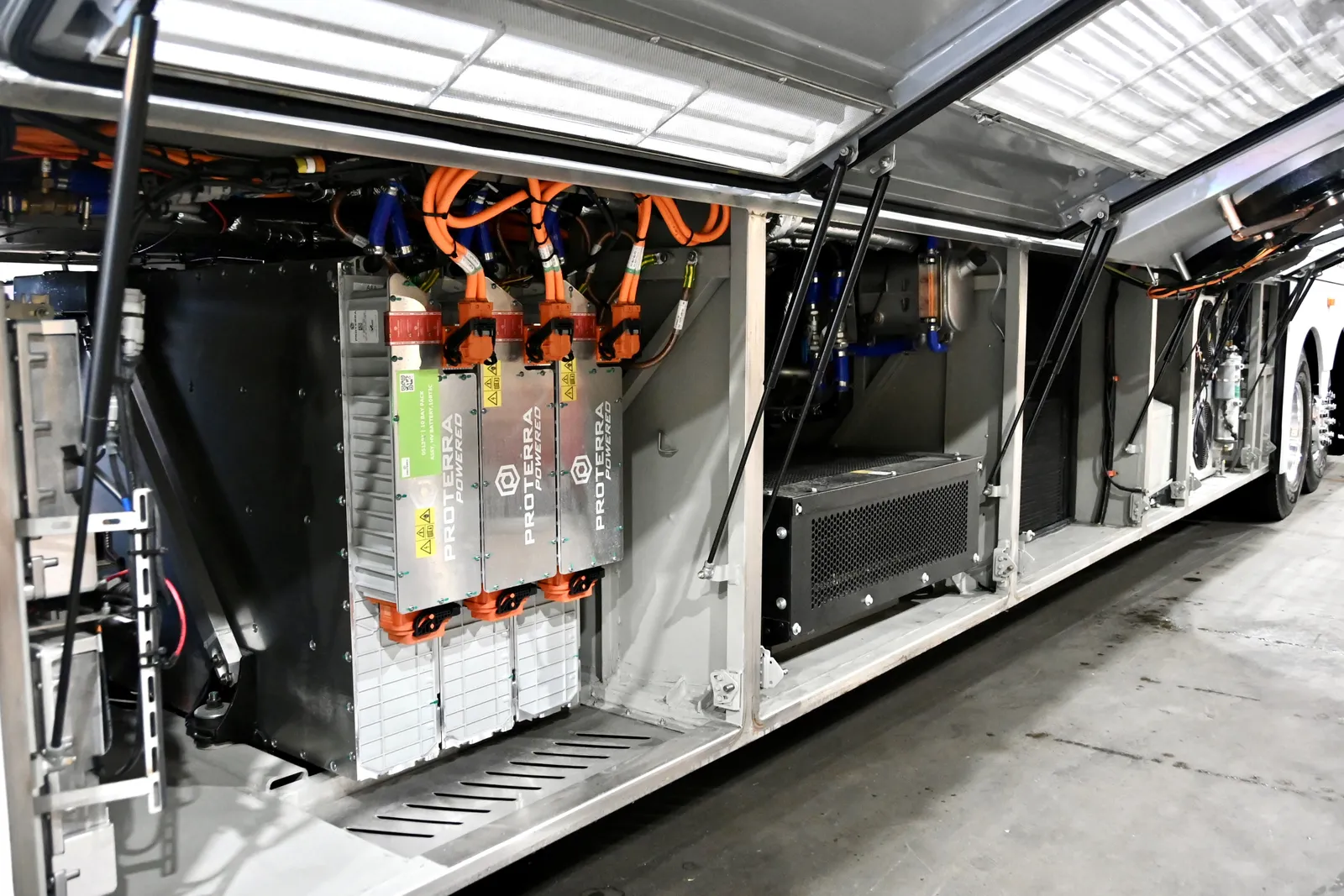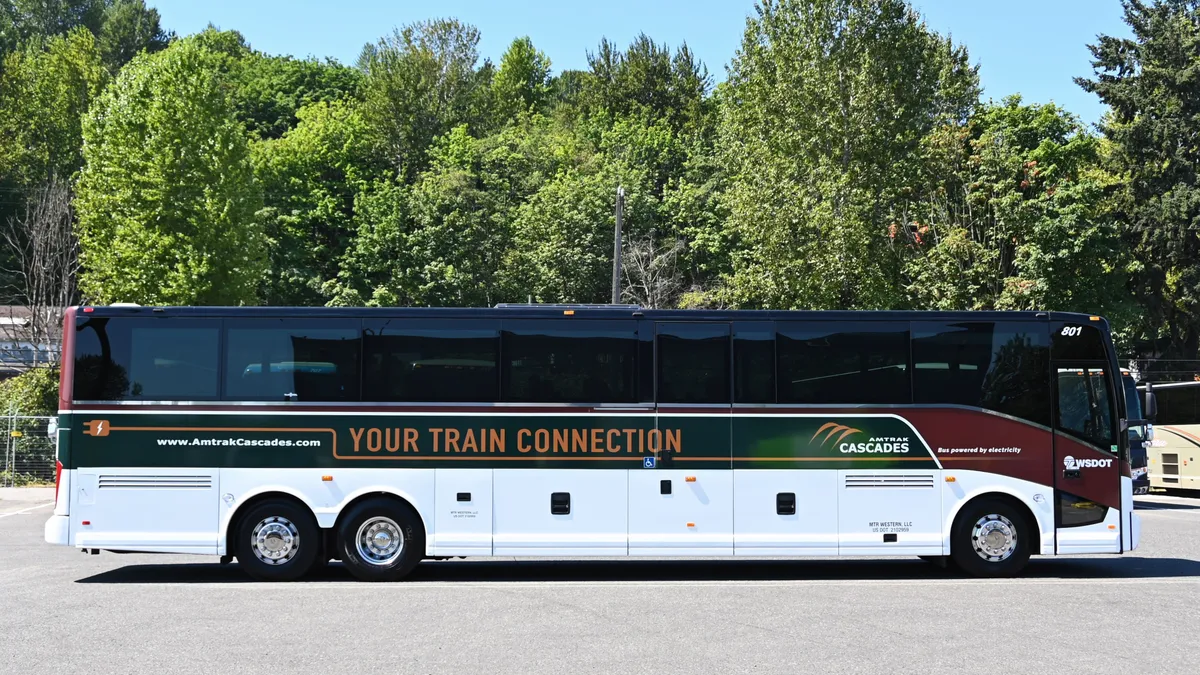Amtrak’s first electric bus began operating Wednesday between Seattle and Bellingham, Washington, to supplement two daily round-trip trains. The round-trip bus journey of nearly 200 miles will run on a single charge using a Van Hool 45-foot motor coach that can seat up to 60 passengers.
While Amtrak is known for its intercity passenger trains, the company also serves many destinations with dedicated buses that connect with and coordinate schedules with Amtrak trains. But unlike electric city transit buses, which can return at night to their depots to recharge, the lack of bus-specific, over-the-road charging infrastructure means intercity bus operators have had limited opportunities to electrify longer routes.
That’s beginning to change: In July, ABC Companies, the North American distributor for Van Hool motor coaches, established a charging facility in Newark, California, capable of charging up to 40 electric buses. James River Transportation, based in Virginia, and Jefferson Lines, a Midwest scheduled bus operator, tested and demonstrated battery-electric buses for intercity service in 2022.
MTRWestern, which participated in a “zero-emissions tour” with ABC Companies last year, won the contract with Amtrak to operate the Bellingham service. Jeremy Butzlaff, president of MTRWestern, said in an interview that when Amtrak put the route out to bid, he thought, “This would be a really perfect route that we could electrify and be the first in the nation.”
Butzlaff said the company installed chargers in Seattle, and the 260-mile range of the Van Hool CX45e was more than enough to eliminate the need for charging in Bellingham. “We're pretty excited to finally get that first one on the road,” he said.
Competitors or collaborators?
With intercity bus companies both competing with and collaborating with Amtrak, it’s unclear how the passenger railway’s planned expansion will affect the private bus companies. Both Amtrak and bus lines are continuing to recover from ridership losses during the pandemic. While Amtrak cut service and staff and received $1 billion in CARES Act support in 2020, nearly one-fifth of motor coach companies in the U.S. went out of business that year.
Despite those setbacks, intercity bus service still appears to be undergoing a renaissance. Bus operators have introduced first-class and sleeper-bus options along with expanded schedules, “accelerating the transformation of an industry that many regarded as stodgy and stuck in a bygone era just a few years ago,” according to a February 2023 report from the Chaddick Institute for Metropolitan Development at DePaul University. The report sees ridership on intercity bus lines returning to between 80% and 85% of pre-pandemic levels by the end of this year.
Flixbus, a brand of Munich, Germany-based Flix, which acquired Greyhound in 2021, has built a web of partnerships with independent bus operators in the U.S. Megabus partners with several bus lines as well. Amtrak operates bus services to more than 100 communities in conjunction with private contractors under the Amtrak Thruway brand. Bus operators have also filled gaps in Amtrak service. Trailways of New York added bus service to Montreal in July after Amtrak suspended its daily round-trip train due to a 10-mph speed restriction north of the U.S. border put in place by the host railroad, Canadian National.
Butzlaff said collaboration with Amtrak, for bus operators, is “super important” and sees it as a benefit to the motor coach industry, raising the visibility and acceptance of bus travel. “I think it's just a benefit to the entire industry,” he said.

After Amtrak received a $66 billion infusion of funds from the 2021 infrastructure law, more than 90 applications for new Amtrak intercity passenger rail routes under 750 miles were submitted to the Federal Railroad Administration, Amtrak’s CEO, Stephen Gardner, told a House committee in June. Amtrak is also in talks with Texas Central Partners on a new high-speed rail route between Dallas and Houston. The Chaddick Institute says in a 2022 report that “The Amtrak Thruway bus system is positioned for dramatic expansion as federal and state agencies work to enhance the country’s rail-passenger network.”
In the institute’s July 12 email newsletter, its analysis found that rail routes with four or more daily trains, along with attractive fares and comfortable stations, “are a strong deterrent to intercity bus expansion.” Institute Director Joseph Schwieterman said in an interview, “There is a real headwind for intercity bus service when there are good, inexpensive Amtrak offerings, and it's pretty consistent around the country.”
With federal support behind adding new routes or increasing Amtrak service along existing routes, Schwieterman said, “That is giving a real boost to the competition, which suggests that bus lines begin to start working with Amtrak more aggressively or systematically than in the past,” including on new feeder routes.
Schwieterman also noted, however, that “adding Amtrak frequencies or Amtrak service is a notoriously slow process,” thus increased bus service along proposed routes could be an “incremental step toward boosting train frequencies.”
The future of electric intercity buses

Orders for electric transit buses are shattering records since the Federal Transit Administration awarded nearly $1.7 billion in grants for low- or no-emission buses, which will fund the purchase of 1,700 such vehicles. But despite tests, demonstrations and a pilot program by FlixBus last year running an electric bus between Philadelphia and Washington, D.C., route distance and charging availability remain roadblocks to greater adoption.
Nevertheless, Butzlaff is hopeful. He said the solution is “opportunity charging,” where an intercity bus might stop for 15 or 20 minutes to top up its charge while passengers can grab a coffee or shop at an adjacent retail center. “I’m holding out hope that we'll be able to get some of those done so we can continue to decarbonize our fleet,” he said.




















